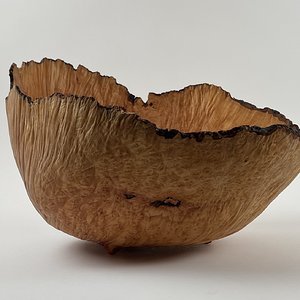-
November Turning Challenge: Puahala Calabash! (click here for details) -
Congratulations to Ted Pelfrey for "Forest Floor" being selected as Turning of the Week for November 4, 2024 (click here for details) -
Welcome new registering member. Your username must be your real First and Last name (for example: John Doe). "Screen names" and "handles" are not allowed and your registration will be deleted if you don't use your real name. Also, do not use all caps nor all lower case.
wet sanding
-

Morphed and Nested
These 3 nested Arbutus Burl bowls are the cores from my previous post. These bowls were all green turned and wet sanded within a few days of being harvested. They are all about ¼” thick and have 3 carved feet so they will sit flat after they morph. Finished with 2 coats of tung oil. This process...- Dave Roberts
- Media item
- arbutus burl green wood morphed natural edge totw wet sanding
- Comments: 4
- Category: Member Galleries
-

Morphed
I was offered a stump from an Arbutus tree that was taken down by arborists due to its proximity to the home. A nice change from the mountain trees we got last winter! The tree was cut down in early October and we cut the stump out the next day, I ended up with 2 large burl chunks. This bowl was...- Dave Roberts
- Media item
- arbutus burl green turning morphed wet sanding
- Comments: 0
- Category: Member Galleries
-

wet sanding green wood platter; contamination problem
Hi all, I need some advice on how to remove what appears to be sandpaper grit stain from a once-turned, green wood platter. The platter was turned from green arbutus (Pacific madrone) that was cut a few months ago. I wet sanded it using waterproof silicon carbide sandpaper, frequently rinsed...- Steve Shulhan
- Thread
- arbutus madrone wet sanding
- Replies: 17
- Forum: Woodturning Discussion Forum
-

Wet Sanding considerations
Hi, all, I am trying to incorporate more wet sanding into my routine, but I'm confused about sequencing. At what point is wet sanding most effective? Early on/coarse grits? Later on/fine grits? Also, I'm wondering about the wetting agent. If my final finish is going to be oil (with or without...- Steven Forrest
- Thread
- sanding wet sanding
- Replies: 7
- Forum: Woodturning Discussion Forum
